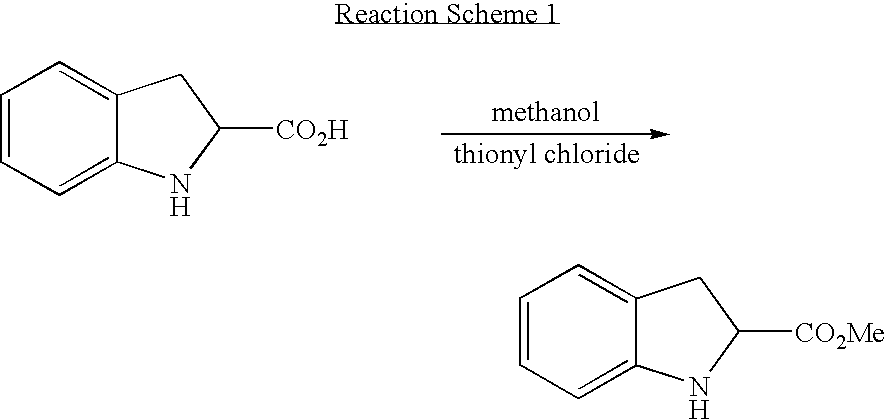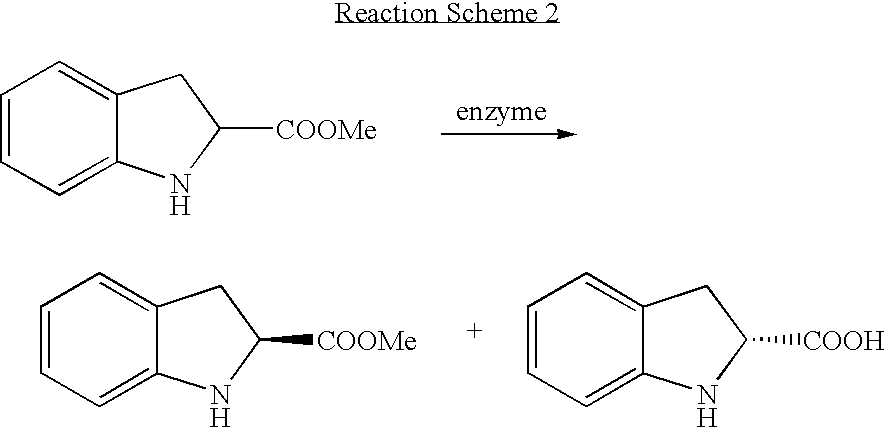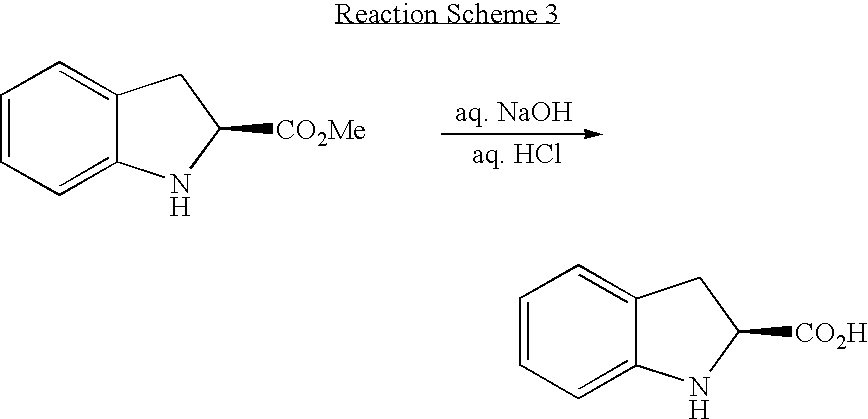Method for preparing (s)-indoline-2-carboxylic acid and (s)-indoline-2-carboxylic acid methyl ester using hydrolytic enzyme
- Summary
- Abstract
- Description
- Claims
- Application Information
AI Technical Summary
Benefits of technology
Problems solved by technology
Method used
Image
Examples
example 1
[0045] Preparation of Racemic Indoline-2-Carboxylic Acid Methyl Ester
[0046] 25 g of indole-2-carboyxlic acid and 130 ml of methanol were placed into a 500 ml reactor equipped with a dropping funnel, after which 11.2 ml of thionyl chloride was slowly introduced through the dropping funnel thereto. After the addition of thionyl chloride, the temperature of the reaction increased to 60° C., at which stirring was additionally performed for 2 hours. The reaction product was distilled under reduced pressure to remove thionyl chloride and methanol, and then added with 130 ml of ethyl acetate, and slowly introduced with 100 ml of a saturated aqueous solution of sodium hydrogen carbonate (NaHCO3) with stirring and allowed to stand. The resultant reaction product was extracted twice with 130 ml of ethyl acetate by use of a separating funnel, after which an organic layer was placed in a 500 ml round bottom flask and distilled under reduced pressure to remove the solvent, thus obtaining 266 g ...
example 2
[0048] Optical Resolution of Racemic Ester Using Industrial Hydrolytic Enzyme
[0049] 80 ml of a 100 mM carbonate buffer solution (pH 8.0) was added with 20 g of the racemic indoline-2-carboyxlic acid methyl ester prepared in Example 1, and controlled in pH 8.0, and then further quantitatively added with 1 g of Savinase (Novo) for the enzymatic resolution. The reaction was carried out at 35° C. As such, the pH was maintained in the range of 7.8 to 8.2, using a 5N sodium hydroxide solution. Thereafter, at each regular interval, 0.1 ml of the resultant reaction product was mixed well with 0.1 ml of the saturated aqueous solution of sodium hydrogen carbonate, and then extracted with 0.5 ml of ethyl acetate, and thus analyzed by use of a gas chromatography.
[0050] As for the gas chromatographic conditions, a silica-filled capillary column (Beta-DEX 120, 30 m×0.25 mm×0.25 m, Supelco) was allowed to stand at 160° C. for 1 min, and increased to 180° C. at a rate of 1° C. / min, and then allow...
example 3
[0054] Preparation of (S)-indoline-2-Carboxylic Acid Through Hydrolysis
[0055] Into a 250 ml reactor equipped with a pH meter, 8.1 g of (S)-indoline-2-carboxylic acid methyl ester prepared in Example 2 and 50 ml of 1N aqueous sodium hydroxide solution were placed and strongly stirred at room temperature. Whether (S)-indoline-2-carboxylic acid methyl ester was converted to (S)-indoline-2-carboxylic acid was confirmed. Then, while the temperature of the reactor was maintained at 20° C. or less, 1N aqueous hydrochloric acid solution was slowly added to the reactor to control pH 5. The resultant reaction product was extracted three times with 50 ml of ethyl acetate by use of the separating funnel, and the organic layer was placed into a round bottom flask. The solvent in the organic layer was removed through distillation under reduced pressure, to give 7.0 g of (S)-indoline-2-carboxylic acid. The thus prepared (S)-indoline-2-carboxylic acid was analyzed for optical purity by means of li...
PUM
| Property | Measurement | Unit |
|---|---|---|
| Temperature | aaaaa | aaaaa |
| Fraction | aaaaa | aaaaa |
| Time | aaaaa | aaaaa |
Abstract
Description
Claims
Application Information
 Login to View More
Login to View More - R&D
- Intellectual Property
- Life Sciences
- Materials
- Tech Scout
- Unparalleled Data Quality
- Higher Quality Content
- 60% Fewer Hallucinations
Browse by: Latest US Patents, China's latest patents, Technical Efficacy Thesaurus, Application Domain, Technology Topic, Popular Technical Reports.
© 2025 PatSnap. All rights reserved.Legal|Privacy policy|Modern Slavery Act Transparency Statement|Sitemap|About US| Contact US: help@patsnap.com



